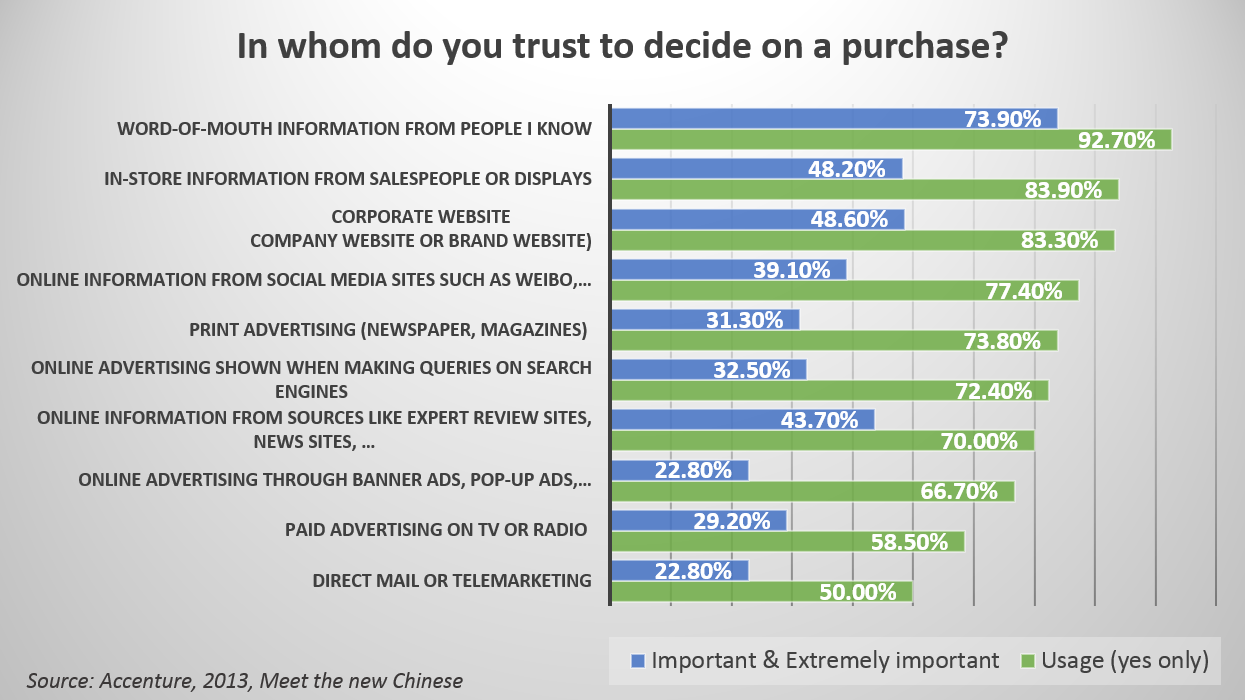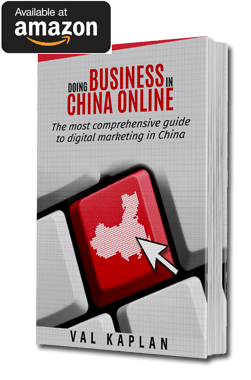The Chinese consumer landscape is changing fast. Companies must adapt quickly to keep up. This article focuses on the 3 key points that require your attention and lead to a successful digital communication in China.
To this end, the understanding of brand building power through digital and mobile communication and knowing how to effectively insert themselves into the ongoing conversations are crucial and major factors; especially for any company aiming at the Chinese consumers.
According to a report by McKynsey, consumption will account for 43% of total GDP growth by 2020, compared with a forecast contribution from investment of 38%. Chinese consumers are an opportunity and will probably continue to be as they get richer. But there are still some unchanged variables like: Chinese pragmatism. They rely on multiples channels to get information about products and services. And as you can see in the graphic below, most of these channels are online platforms. This trend is still ongoing as the shopping behavior of Chinese people changes, they have lesser time to shop in physical stores so they are embracing new ways of experiencing the products and consumption.
3 Key Points for a Successful Digital Communication in China
Social Media
What is leading to the adoption of social media by Chinese people?
- The separation between families due to the rural exodus
- Young people that were born or grew up without siblings and during the Internet revolution
- Inexpensive access to the Internet
Why commit time and resources in developing your brand on social media platforms?
Here are some numbers to convince you from the Wearesocial report on Digital, Social & Mobile in China in 2015:
- QQ platform has 843 million users, Wechat has 600 million users;
- 714 million people in China are active on least one social media platform.
These platforms are also:
- Effective tools to build a brand by initiating conversations with consumers, creating and posting engaging social objects;
- Marketing tools: Chinese online buyers often post reviews or have their own blog where they discuss their latest acquisitions. This is the KOL phenomenon.
KOL stands for Key Opinion Leader. In China, they can be used to advertise a brand on a large scale as some of these KOL have millions of followers on Weibo. Paid advertisement campaigns on a platform like Weibo are not as efficient as on platforms like Facebook or Google. The rate of people clicking on these ads is usually low because Chinese consumers have distrust in traditional advertisement.
As mentioned above, Chinese consumers have a tendency to trust friends, coworkers when they research a product. They also trust their idols or online friends. That is where the KOL are useful for a digital communication strategy. They allow a company to reach successfully a specific target audience.
E-tailing
Why brands should be present on E-commerce platforms?
For the first half of 2015, E-commerce represent 10% of China’s total retail sales value. In that same period, E-commerce generated 253 billion dollars (1.6 Trillion RMB) of revenue in China. The major online companies Alibaba (which owns Taobao) and 360buy.com have established a national position, ranking among China’s top ten retailers. E-tailing platforms can help foreign companies building clear and consistent brand images and are a cost-effective way to reach consumers in small cities.
Due to the size of the Chinese territory, installation of physical stores takes a lot of time and money. The E-commerce system in China is well organized and can be seen as a replacement allowing companies to fill the gaps from lack of a physical store network.
The competition between E-tailers is growing. It naturally led to a cut of product prices, especially in the three major segments of Chinese E-commerce market: Apparel, Household appliances and recreational products. Transportation and health care product are also growing online markets.
The development of e-tailing is boosting consumption. The scope of opportunities is clearly widening for inside and outside players.
E-mobile
In July 2015, 20% of the population used a mobile phone to buy a product and 29% used a computer, 15% of the population used a mobile phone to research a product and 18% use a computer. It is estimated that, in 2015, half of all Chinese online consumers will be M-commerce consumers.
The price of mobile phones in China is dropping every year. It is a more affordable and convenient way to access the Internet. So much that they have replaced computers to become the main devices for accessing internet in 2012.
Why brands need to invest on mobile?
- Enable direct contact with the target audience: messaging apps (WeChat, QQ, KakaoTalk, Line, etc.) create a 1-to-1 communication with real end customers. For example: a company can create a WeChat official account where consumers can directly make a payment;
- Tailor-made and segmented content for brands;
- Optimize marketing expenses by geographic targeting and customer data analysis.
A successful digital communication will be the result of the integration of these 3 resources. Never forget that the objective is to make the brand concerned recognizable, trustworthy and different from its competitors. The business strategy must be carefully planned and also include: Point of sales, client relationship management and the product. Then, these factors must be coherent with each other and consistent for a good implementation in China.





